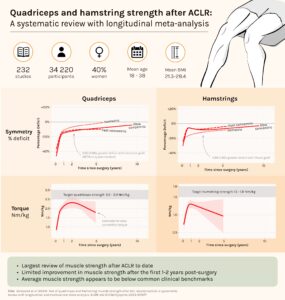Keywords: anterior cruciate ligament, muscle strength, rehabilitation, knee
This blog summarises the findings of a recent systematic review of quadriceps and hamstrings strength after anterior cruciate ligament reconstruction (ACLR)(1).
Why is this study important?
After ACLR, weakness of the thigh muscles (quadriceps and hamstrings) is common, if not universal, with implications for risk of re-injury and development of osteoarthritis. Quadriceps and hamstring strength is often reported as a primary or secondary outcome in studies, yet we lack detailed understanding of how muscle strength changes over time after ACLR. Detailed reporting of any strength deficits across contraction types could help clinicians interpret their findings and set realistic expectations. Comparing the ACL-injured limb to the contralateral (opposite) limb (using the limb symmetry index) and to uninjured controls is also critical for context.
How did we go about this?
We reviewed all studies that measured quadriceps (knee extensor) and hamstring (knee flexor) strength after primary ACLR. Muscle strength had to be compared to either the: (i) contralateral limb (within-person comparison); or (ii) uninjured control limb (between-person comparison). We included studies with a sample size of at least 50 people, with mean age of 18-40 years. Data were grouped by the type of contraction (slow concentric (≤120°/s), fast concentric (>120°/s), isometric, eccentric). We used a statistical approach for our meta-analysis that allowed us to estimate how muscle strength differs over time after ACLR by including multiple timepoints (where available) per study.
What did the study find?
We included 232 studies of 34,220 people (40% women). Muscle strength was most commonly measured in the first 12 months post-surgery, with timepoints up to 10 years post-surgery included for analysis.
Muscle strength followed a similar trajectory for the quadriceps and hamstrings for all contraction types – steep initial improvement in the first year, tailing off by 12-18 months post-surgery, with minimal improvement after this time. At 1 year post-ACLR, slow concentric quadriceps strength was estimated to be 85% of the contralateral limb – below commonly recommended benchmarks of 90% limb symmetry index. Slow concentric hamstring strength was slightly more symmetrical, approximately 94% of the contralateral limb at 1 year.
Concerns have been raised about comparing strength to the contralateral limb only (e.g. with a limb symmetry index), so we also presented comparisons to uninjured controls. Unfortunately, there was much less data available (only 19% of included studies), and no follow-ups >5 years post-surgery. Strength deficits were generally larger when compared to uninjured controls.
We also presented an exploratory analysis of studies measuring muscle strength normalised to body weight (Nm/kg). Quadriceps strength peaked at approximately 2 years post-surgery at 2.32 Nm/kg, while hamstring strength peaked at approximately 1 year post-surgery at 1.30 Nm/kg. Both of these estimates are below common benchmarks from the literature (e.g. 2.5-3 Nm/kg for the quadriceps(2–4)).
The graft used in ACL surgery may also contribute to strength deficits: quadriceps strength was 0.83-0.98x lower in those with an extensor graft (bone-patellar tendon-bone or quadriceps tendon), while hamstring strength was 0.84-0.92x lower in those with hamstring grafts.

What are the key take-home points?
- This review is the largest summary of muscle strength after ACLR to date.
- Muscle strength of the quadriceps and hamstrings improves sharply in the first year post-ACLR, with limited improvement after this time.
- Average muscle strength was below common benchmarks at 1-2 years post-surgery.
- Graft type may magnify deficits by an additional 5-10%
For information on hip and lower-leg strength please see another recent systematic conducted alongside this review (5), as well as a review of hop performance also recently published (6).
Authors: Michael Girdwood
References:
- Girdwood M, Culvenor AG, Rio EK, Patterson BE, Haberfield M, Couch J, et al. Tale of quadriceps and hamstring muscle strength after ACL reconstruction: a systematic review with longitudinal and multivariate meta-analysis. Br J Sports Med. 2024 Oct 10; Available from: https://bjsm.bmj.com/content/early/2024/10/10/bjsports-2023-107977
- Kuenze C, Hertel J, Saliba S, Diduch DR, Weltman A, Hart JM. Clinical Thresholds for Quadriceps Assessment After Anterior Cruciate Ligament Reconstruction. 2015
- Buckthorpe M, Danelon F, La Rosa G, Nanni G, Stride M, Della Villa F. Recommendations for Hamstring Function Recovery After ACL Reconstruction. Sports Med. 2021 Apr 1;51(4):607–24.
- Buckthorpe M. Optimising the Late-Stage Rehabilitation and Return-to-Sport Training and Testing Process After ACL Reconstruction. Sports Med. 2019 Jul;49(7):1043–58.
- Girdwood M, Culvenor AG, Patterson B, Haberfield M, Rio EK, Hedger M, et al. No sign of weakness: a systematic review and meta-analysis of hip and calf muscle strength after anterior cruciate ligament injury. Br J Sports Med. 2024 May 1;58(9):500–10.
- Girdwood MA, Crossley KM, Rio EK, Patterson BE, Haberfield MJ, Couch JL, et al. Hop to It! A Systematic Review and Longitudinal Meta-analysis of Hop Performance After ACL Reconstruction. Sports Med. 2024 Oct 16